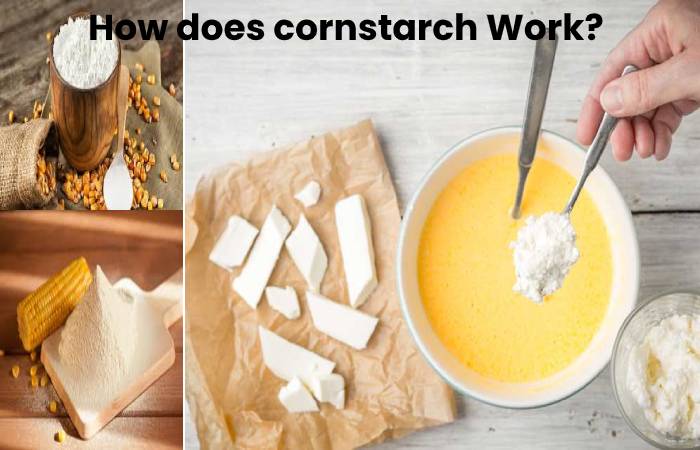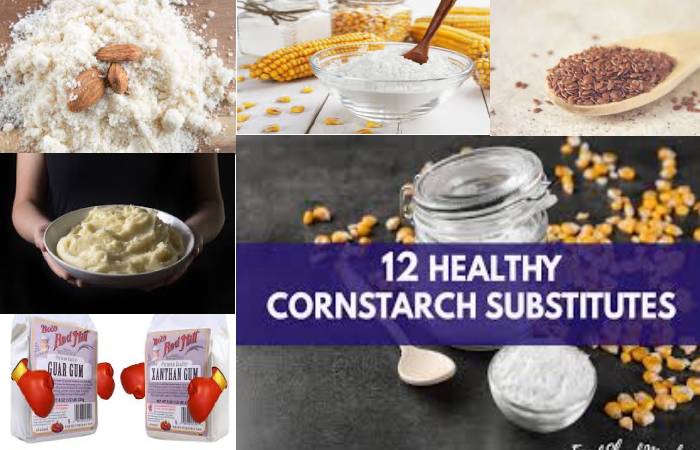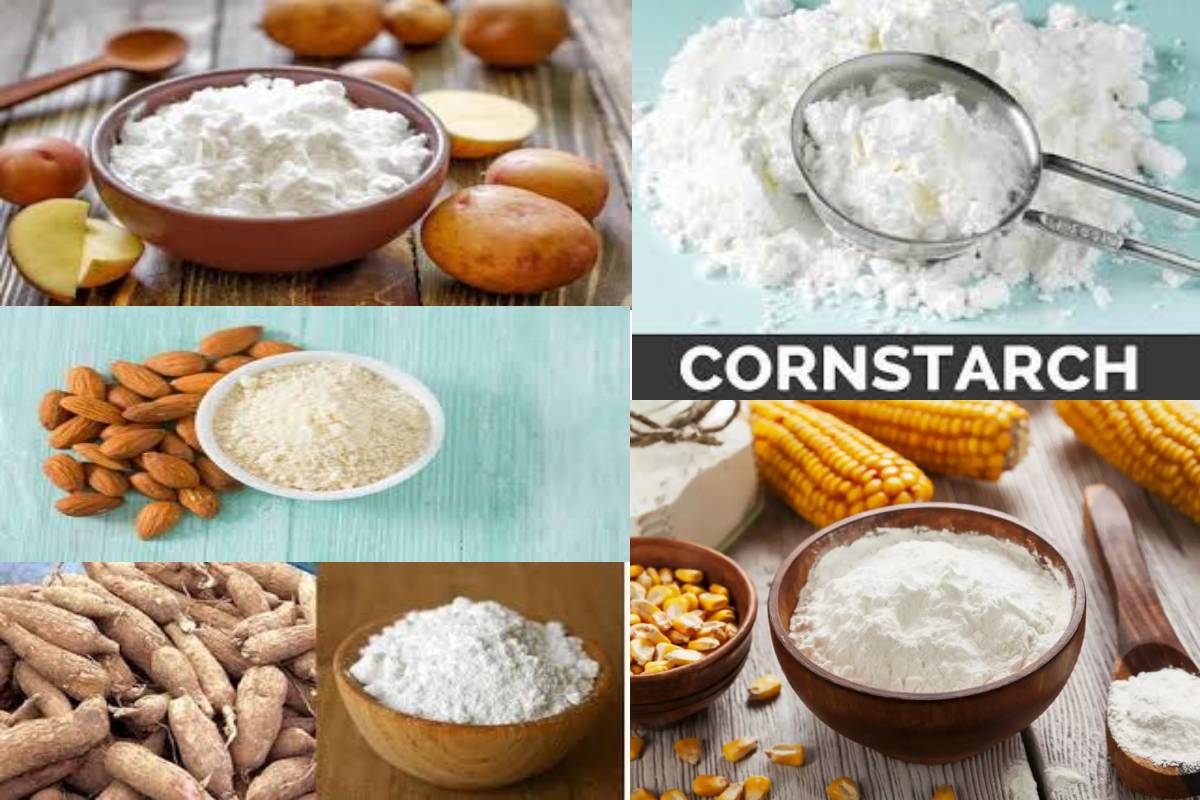Table of Contents
Cornstarch Definition
Cornstarch, sometimes called cornmeal, is produced by grinding the endosperm of corn, creating a powder with a consistency similar to that of flour.
It is a prevalent ingredient found in almost all supermarkets and online stores.
It contains carbohydrates and is gluten-free, so people who shy away from gluten can freely use it in their dishes. Cornstarch is a unique product for the kitchen, but there are alternatives in case we run out of it.
How does cornstarch Work?

When used as a thickener, mix it with room temperature water to form a gel. Then, once exposed to heat, it begins to thicken the mixture, serving its purpose.
It is known as a process called gelatinization. Compared to ordinary flour, it is twice as powerful when it comes to thickening.
Cornstarch also has an added benefit: it’s anti-caking. It can absorb moisture around it, preventing foods like cheese or sugar from becoming too dense.
Why Use Cornstarch?
As it makes from corn endosperm, it has all the benefits that corn offers. Consuming cornstarch in dishes gives you a needed boost in calories and energy.
It can also help hypoglycemic patients as it can help control sugar levels in the body. Lastly, it also contains some essential minerals, such as phosphorus, magnesium, calcium, iron, zinc, and potassium.
Best 12 Substitutes for Cornstarch

Please take note of these 12 alternatives to cornstarch to muddle through when you run out of it.
1. Common Flour
- As the name suggests, all-purpose flour (also known as white flour) is beneficial for all types of baked goods and even non-baked recipes.
- You will find this ingredient in almost every kitchen. It is what beginning bakers usually use at first if they are not already familiar with the different types of flours.
- It has a protein content of between 10% and 11%, the right amount to make cakes with a balanced texture. Most of the time, this is the type of flour that people already have in their homes.
- One tablespoon of cornstarch is worth more than two tablespoons of flour.
- Just make sure to keep the broth simmering for four to five minutes to get rid of the taste of the flour. Also remember that, unlike what happens when using cornstarch, your finished product will not have a glossy finish.
2. Tapioca Starch
- Tapioca starch, or tapioca flour, is derived from the roots of cassava, which makes it rich in carbohydrates. It is also one of the purest forms of starch that can find.
- Although it is shallow in other micronutrients and macronutrients, it still has other benefits, making it very healthy.
- Using four teaspoons of quick-cooking tapioca starch or two tablespoons of granulated tapioca starch is equivalent to one tablespoon of cornstarch.
- Unlike white flour, tapioca starch can provide a glossy finish to the finished product. It is the best ingredient to use if your recipe calls for the dish to be cold.
- Tapioca itself has many benefits. First of all, it is gluten-free, nut-free, and grain-free. Second, it is low in calories, fat, and sugar. Lastly, it is odourless and tasteless, unlike ordinary flour.
3. Rice Flour
- Rice flour made from finely ground grains of white or brown rice. It has a coarse texture, unlike other flours that tend to be more nuanced and dustier. It has a neutral taste, similar to that of standard flour.
- Its use as flour, rice is also a staple in some parts of Asia due to its ability to be quickly filled and the health benefits it provides. The amount of carbohydrates it contains makes it a good source of energy for the day.
- The thickening properties of rice flour are almost the same as white flour, so you should use a ratio of two parts of rice flour to each amount of cornstarch required in the recipe.
- It can be mixed with water at any temperature to create a paste and can be used to thicken clear liquids due to its colourless attribute.
4. Wheat Flour
- Another substitute for cornstarch is whole wheat flour. Due to its composition, it adds health benefits that ordinary flour does not have, similar to those offered by most entire wheat cereals.
- As its name suggests, this type of flour is made with whole wheat grains, retaining the nutrients present in the bran, the endosperm and the germ.
- To use wheat flour as a thickener, you must first combine it with cold water to form a paste. You can use the same proportion of wheat flour as when you use white flour, so replace one part of cornstarch with two pieces of wheat flour.
- Keep in mind, however, that wheat flour is not gluten-free, so be sure to avoid using it if other diners are trying to avoid gluten.
5. Arrowroot
- Arrowroot is a white, powdery substance extracted from plants of the same name, generally found in parts of Western India.
- Usually, its use to heal wounds that came from arrow shots, thus giving it its name. It obtains by grinding the dried roots of this plant into a fine powder.
- It is also gluten-free and contains a high amount of fibre, more than cornstarch does. When mixed with water, it can turn into a clear gel, making it a good substitute for cornstarch when needed to thicken liquids.
- When used as a replacement, one part cornstarch equals two parts arrowroot. Like cornstarch, it produces a smooth, shiny finish for your sauces and soups, and can even withstand the low temperatures of a refrigerator.
- It is ideal to be used in dishes and recipes using the egg as a base as it thickens very quickly.
6. Potato Starch
- As its name suggests, potato starch obtains by extracting the natural starch content of the potato.
- However, to produce it in large quantities, many chemicals are used, so when buying in stores, it must bear in mind that it is not one hundred per cent organic in nature, although its origin implies otherwise.
- It has a neutral or mild flavour, so it should not affect the result of your recipe. It is also gluten-free. Some of its health benefits are that it is high in carbohydrates and low in fat.
- Unlike flour, potato starch can substitute for cornstarch in a one-to-one ratio. For every tablespoon of cornstarch, you can use an equal amount of potato starch.
- Some recipes call for potato starch to add as it can easily absorb water and has a faster thickening time than regular flour.
- However, when using it, you should not heat the dish for too long, as it can break down the starch, rendering its thickening power useless.
7. Almond Flour
- Almond flour made from ground almonds. It contains low carbohydrates and minerals such as magnesium, calcium and zinc, as well as vitamin E and protein.
- It boasts a moist and delicious characteristic and has other added benefits in terms of taste and ease of use. Also, it has a low sugar content and helps in weight loss. Lastly, increase energy levels. It will be helpful for those people who have a very active lifestyle.
- Besides all these benefits, almond flour is also a good substitute for cornstarch. You can replace one teaspoon of cornstarch with an equal part of almond flour.
- One of its natural attributes is its distinctive almond flavour, which can contribute to your dishes once you use it.
- It is the ideal replacement for recipes that need to taste sweet and sour and can enhance the flavour of desserts such as cookies, muffins, cakes, and scones.
8. Glucomannan
- Glucomannan a powder substance derived from the roots of the plant called Konjac, which is usually found in Asia and is used both as an ingredient and as a medicinal substance.
- It has zero calories and carbohydrates, as it knows as a “pure fibre,” which makes it an ideal substitute to make your recipe suitable for people who follow a strict diet.
- When substituting glucomannan for cornstarch, keep in mind that it is a more powerful thickener, so the replacement amount should be less than the amount of cornstarch the recipe calls.
- For example, if you need two teaspoons of cornstarch, the equivalent amount of glucomannan should only be a quarter teaspoon. Make sure to mix it with cold water before cooking as well, as it tends to clump when exposed to heat.
- Like cornstarch, it adds a glossy finish to the finished product and won’t affect the taste of your food either.
9. Ground Flax Seeds
- Flax seeds one of the so-call “superfoods.” As the name suggests, they are the seeds of the flax plant ground to form a powder.
- Consuming flaxseeds gives one a boost in vitamins and minerals, and they are a good source of fibre and omega-3 fatty acids. Vegetarians and vegans can also consume flax seeds for protein and fat.
- To use flaxseed as a substitute, all you have to do is mix one tablespoon of ground seeds with four tablespoons of water, making a mixture that is roughly equivalent to two tablespoons of cornstarch.
- However, flaxseed has a sandy consistency, unlike the smoothness of cornstarch, so take note of this when using it for your dishes.
10. Xanthan Gum
- Xanthan gum a substance derives from exposing sugar to a bacteria called Xanthomonas Campestris to ferment it.
- The resulting gel dries and crushed into a fine powder, making it one of the most effective thickeners.
- You must be careful not to use too much, as it can affect the digestive system of some people.
- To replace cornstarch with xanthan gum take a small amount and slowly add it to the mixture. It is a very powerful thickener.
- Make sure to combine the required amount of cornstarch with the same amount of xanthan gum.
11. Guar Gum
- Guar gum made from legumes called guar beans and is a vegetable gum like xanthan. It made from the endosperm of the grains, which finely ground to produce a powder.
- It knows for its low-calorie content and high fibre content, which makes it a more nutritious substitute for cornstarch and an excellent thickener.
- Compared to xanthan gum, it is much more affordable but has the same thickening power. You can use the same amount of guar gum to replace the required amount of cornstarch in the recipe.
- Just remember to do the same as for xanthan gum: start with small amounts, then slowly add more to get your desired level of thickness. Don’t add too much at once, so the mixture doesn’t become slimy.
12. Instant Pot Mashed Potatoes
- Oddly enough, instant mashed potatoes can use thick soups or sauces when they are too runny. It is advisable to process the mashed potatoes first to avoid clumping in the mixture.
- Substitute a tablespoon of instant mashed potatoes for a tablespoon of cornstarch. Add more if your recipe needs it.
Other Techniques Substitutes for Cornstarch
- If you need to thicken your recipes but don’t want to use substitutes you can use the following techniques.
- Cook over low heat your plate may help make it thicker. To do this, try to use a short amount of heat, then cook the food for an extended period. It will result in evaporation of the liquids, increasing the viscosity or thickness of the sauce or soup.
- Another useful technique is the use of vegetables. If you have vegetable scraps in the refrigerator, try mixing them in a tomato-based sauce. It will make it thicker and more nutritious.
- You can use sour cream or Greek yoghurt. These have a natural thickness to it. Also, it enhances the flavour of food by adding that characteristic sour taste.
- Greek yoghurt is also very healthy due to its added benefits. You can make food not only more nutritious and delicious but also suitable for the beneficial bacteria that are usually present in it.
Conclusion
When it comes to thickening sauces, stews and soups, there are many substitutes to cornstarch.
Many of these thickeners have different nutritional properties than cornstarch and can suit various dietary preferences.
If you’re looking to add a little bit of extra fibre to your recipes, are on a low-carb diet or run out of cornstarch, there are undoubtedly alternative thickeners to consider.
Also Read: Vegan Diet – Definition, Best 8 Supplements, and More
- MORE INFO:- technoologyen

